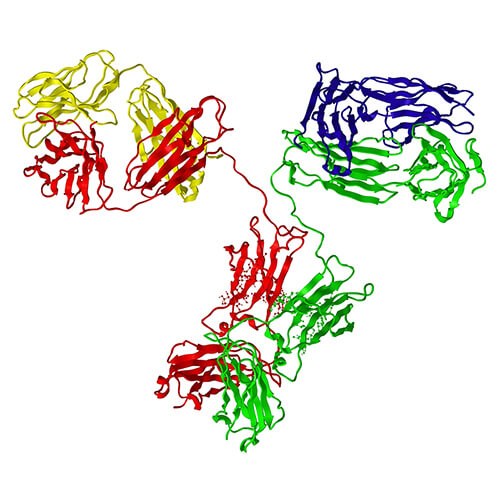Component C3 is the most abundant complement protein in the serum. C3 is a 190 kDa protein, composed of two glycoprotein chains associated with disulfide bonds. C3 is cleaved by C3 convertase resulting in the production of a small fragment C3a, which is a strong anaphylatoxin that can also suppress the polyclonal response of B cells. The larger C3b fragment is an opsonin and forms part of the classical and alternative pathway enzymes that activate C5 and the other terminal components. Patients with C3 deficiency are characterized by arthralgias and vasculitis skin rashes (like serum sickness), whereas others develop symptoms like glomerulonephritis or systemic lupus erythematosus. Anti-human C3 can be used to detect C3 levels in the patient samples and can thus be used in the diagnosis of autoimmune diseases.
Anti-Human C3
Product Code : 00-ABD-MM-0C3-001
Available products:
| Product Name (New) | Product Code | Grade |
|---|---|---|
| Goat Anti-Human C3, Whole Serum | 00-ABD-MM-0C3-001 | Whole Serum |
Specifications:
| Test Parameters | Acceptance Criteria |
|---|---|
| Product Code | 00-ABD-MM-0C3-001 |
| Host | Goat |
| Immunogen | Human C3 |
| Grade | Whole Serum |
| Physical Appearance | Straw to brownish yellow clear liquid without any suspended particles |
| Titre (Reverse Single Radial Immunodiffusion) | > 7.0 mg/ml |
| Shelf life | 3 years |
| Buffer details* | Tris Saline with 15mM NaN3 pH 7.4 ± 0.2 |
| Total Protein (Biuret Method) | 50 to 130 mg/ml |
| Cholesterol (CHOD Enzymatic method) | ≤ 50 mg/dl |
| Specificity (Immunoelectrophoresis) | Monospecific to C3 when reacted with pooled human plasma & 2X normal human serum |
| Specificity (Ouchterlony) | Monospecific when reacted with normal human serum |
| pH | 7.0 to 8.0 |
| Storage conditions | 2 to 8 ºC |
For research use or further manufacturing purposes only
